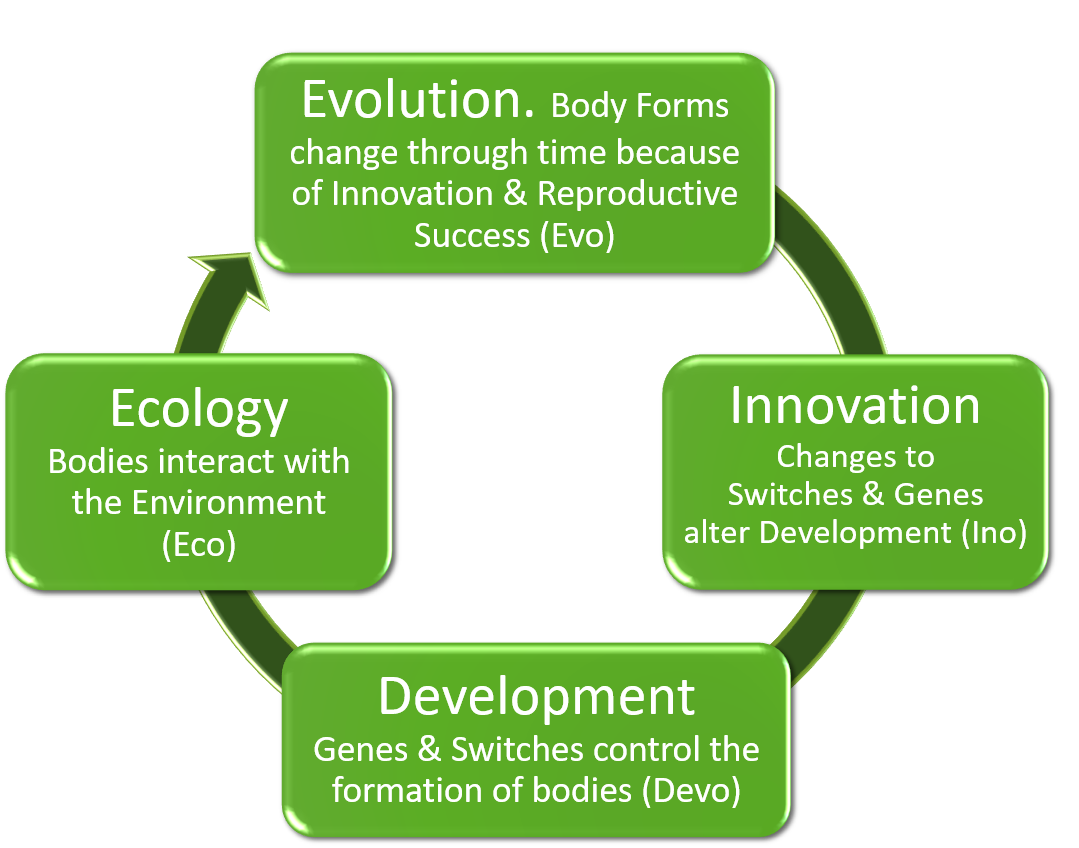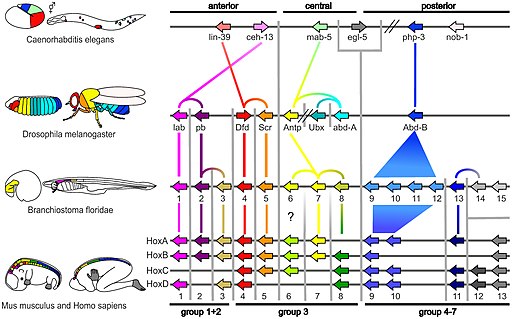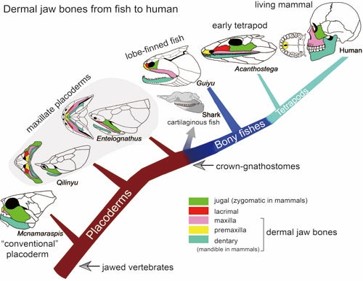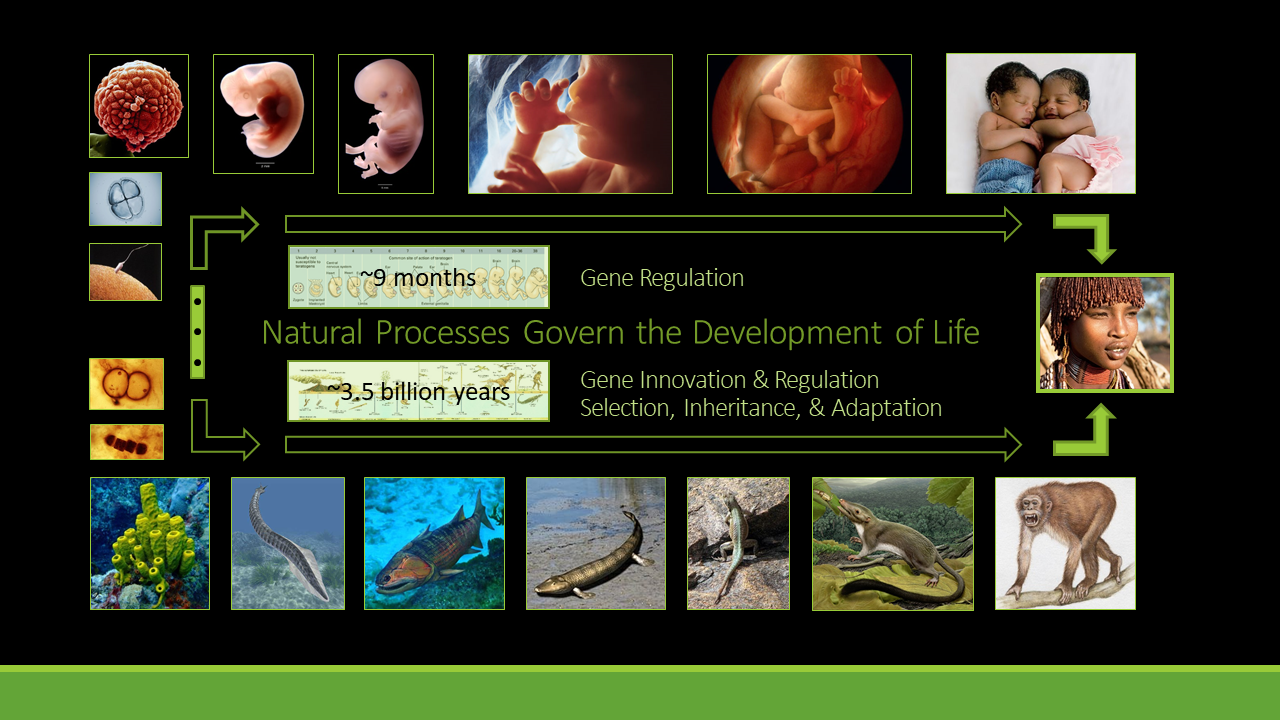
Explore 4.28 How New Species Form from Existing Species
Learning Objectives
By the time you have completed the 4.28. Introduction & Exploration Activities, you should be able to:
- Describe how evolution results from genetic innovation, development, selection, and inheritance.
- Identify observations that fail to falsify the Theory of Evolution. Also, describe how the Theory of Evolution fulfills the functions of a scientific theory.
- Describe how confident humanity should be that the Theory of Evolution contains abundant truth.
How Evolution Works
Describe how evolution results from the interplay between gene innovation & regulation, selection, inheritance, embryological development, and adaptation.
Before preceding, review how microevolution produces new species (macroevolution) by watching this video (15.5 min):

Beginning with innovation, give an example of events that could occur at each step that could result in the evolution of a population. Include each of the terms above at the appropriate step in the cycle.
Innovation
Development
Ecology
Evolution
Predictions from Theory of Evolution
Identify several significant predictions of the Theory of Evolution. Also, identify observations that fail to falsify (confirm) the predictions of the Theory of Evolution. Finally, describe how the Theory of Evolution fulfills the functions of a scientific theory.
Human Genetic Attributes
Predictions. The genetic predictions of the Theory of Evolution for the human body include these: 1) Humans should share genes with other organisms—especially control genes and 2) Humans, as complex organisms, should have more control genes.
Observations. The diagram below uses color to illustrate the control genes that humans share with a few other animals. Note that simple animals have few control genes. Also note that much of the control gene complexity of animals such as humans results from repurposed copies of the same control genes found in less complex animals. Examples of shared control genes include those that build body segments in all animals and those that build limbs and fins in animals such as mammals, reptiles, birds, amphibians, and bony fishes.

Can these genetic attributes of human bodies falsify the role of lawful body molding in the formation of our bodies?
Embryological Evidence
Predictions. The developmental predictions of the Theory of Evolution for the human body include these: 1) Human embryos should develop similar to other animals, 2) Human embryos should contain the same basic body parts, and 3) Developing body parts should become increasingly distinct (in size, shape, and location) as development approaches birth.
Observations. The images below show human development before birth. As you’ll recall from earlier topics, the first several weeks of human development are very similar (homologous) to those of animals such as fish, amphibians, reptiles, birds, and mammals. For example, in early stages developing humans have tails, gill arches, eyes on the side of the head, etc. As development approaches birth, humans begin to look more like infants. This is accomplished by changes in the size, shape, and position of body parts. For example, the eyes move from the sides to the front of the head, the tail is resorbed, the gill arches form the jaw, middle ear bones, and larynx, etc.



The diagram below illustrates limb formation during human prenatal development and the lawful body molding of limbs from species to species. The left side shows prenatal limb development (circled) and the concentration of the protein produced by the control gene that guides limb development in humans (and in all limbed organisms). The right side of the diagram shows the basic location of bones in animal limbs (middle-right), a few of the stages of limb development from bony fishes to amphibians (bottom), and the shapes and sizes of these bones in a few modern animalsd (top-right). We will refer again to this diagram below.

Can these embryological attributes of human bodies falsify the role of lawful body molding in the formation of our bodies?
Fossil & Anatomical Evidence
Predictions. Fossil and anatomical predictions of the Theory of Evolution for the human body include these: 1) Fossils with attributes identical to modern humans should exist in the recent past 2) Differences between the attributes of human-like fossils and humans should become ever-greater in progressively older fossils, and 3) Through time, fossils should show shifting patterns in the form and function of specific body parts (bones, organs, etc.).
Observations, etc. Our last unit will cover the human fossil record in greater detail. Here we illustrate the general witness of the fossil record—using several diagrams—and then investigate the nature and development of several human body parts that are homologous to body parts in other organisms—mostly using simple examples related to bones. The first diagram below illustrates some of the main hominins (bipedal apes) that have existed on Earth. The bars show when each species appeared and went extinct. The earliest three species are transitional species (not true hominins). In general, the attributes of these species become more human-like through time. As you can see, we are the only hominin species currently on Earth.
The second diagram shows the emergence of attributes that humans share with other animals. Note that relatively few animals share recently developed attributes such as hair or lack of a tail, but many animals share traits that emerged earlier—such as jaws and lungs. The last diagram illustrates the development of living things through time as recorded in the fossil record and in the genes of modern organisms. The earliest life lies at the center and modern life lies at the upper edge of the tree. Note these two patterns: a few simple species developed into many species—including complex animals and plants, and mass extinctions ended some lines of descent and provided niches for surviving groups of organisms to diversify.



Below, we investigate briefly fossil observations of bones found in limbs and skulls. There are many, many, many, …, many more examples from other body parts and pieces. We chose these because they are representative and require little biological or biochemical knowledge. The graphic below summarizes fossil observations of the transition from finned fish to lobe-finned fishes with lungs to amphibians. Attributes vary horizontally (x-axis) and time varies vertically (y-axis). Take a moment to refer again to the limb development diagram we introduced above. Can you see that it belongs here too? Analogous to the development of a human from single cell to infant (and beyond), the fossil record shows the development of attributes through time, from group to group to … to group? As you compare the succession of organisms shown below to the limb diagram above, consider whether or not these patterns are able to falsify an evolutionary origin for the human body.

Our last examples relate to elements of the human head—in the jaw/face and in the ear. The graphic below (left) shows the parts (plates, rods, and blocks) that produce the skull in humans—and in all other animals with skulls. During embryonic development, the expression of control genes (gene regulation) shapes these bones, producing the skull shapes shown in the animal kingdom. While individual bones are homologous organism to organism, developmental shaping produces specific shapes and functions. For example, in humans the colored bones in the generalized head (blocks) are shaped into the bones along the side of the skull and in the voice box.
As mentioned, these bones are shaped differently in other animals, and the fossil record shows how these shapes changed through time. The diagram below (right) shows the reshaping/repurposing of several homologous bones in successive animal groups. Of course, each group uses homologous genes and processes to build these bones. As you know, the skulls represent observations that form patterns that must be explained by any successful theory of life and the lines are interpretations of the evolutionary relationships (descent with modification) that seek to explain the observed patterns.


So, Evolution predicts that each of the parts and pieces of the human body are related by descent with modification to earlier groups of animals. Could this also be true for such specialized body parts as the middle ear bones and sensory machinery that produces the exquisite hearing of most mammals? The diagram below shows how humans hear (left) and how several elements of our auditory system are shaped during prenatal development (top) and how these elements were molded during the history of life (right, top & bottom). You may never have thought about this: the ability to hear provides a relatively weak competitive advantage for animals that live in water, but a powerful advantage to animals that live in air (on land). Not only does acute hearing in land animals help predators find prey and aid prey in detecting approaching predators, but it also helps organisms communicate to find a mate, sound alarm, show emotion, ….
The green lines below illustrate how humans hear: sound (mechanical vibrations in air) moves the eardrum, which transfers the motion to the three inner ear bones unique to mammals. In turn, these bones move fluid in the inner ear. That motion is converted to electrical signals (by inner-ear hairs and sensory cells) that are carried to the brain by nerves. The brain interprets the signals as sound.
The grey lines in the diagram below (top) show how components of the gill arches are shaped into the human auditory system (which includes the three bones of the middle ear) during human prenatal development. Other structures form from the gill arches as well. For example, the jaw and other bones, larynx, muscles, nerves, and arteries. The patterns formed by these nerves is complex and highly inefficient.
The other grey lines (right & bottom) show the molding of homologous bones and sensors through the history of life. The image in the upper right shows the location and shape of human ear bones in earlier organisms—from fishes to amphibians to reptiles to early mammals to humans. Unsurprisingly, these bones are built by homologous genes and processes across these animal groups.
As with the inner ear bones, the components of our hearing sensors are homologous to sensors in more primitive organisms such as sharks and fishes. In these organisms, the sensors (small sacs called neuromasts) are distributed along the body and detect pressure changes that provide fishes with information about how the flow of water around them is changing. In humans, these sensors are used in hearing—to detect small changes in the flow of fluid in the inner ear.

In this section, we brought together fossil, anatomical, developmental, and genetic observations to investigate a few aspects of the human body. Can these attributes of human bodies falsify the role of evolution in forming our bodies?
Lawful Body Molding
Before concluding, we provide you with two additional sets of powerful observations—aspects of life that witness to the reality of lawful body molding. Recall that the molding of bodies involves environmental selection for the attributes of a population that increase reproductive success, and that these interactions across numerous generations act to produce body parts—and the bodies they comprise—that are extremely well adapted to particular functions. Thus, Evolution predicts that the bodies of organisms are well adapted to operate in their environments.
To explore this idea more completely, let’s imagine just one aspect of a body that would influence its reproductive success: it’s overall shape. Now, let’s image a particular lifestyle in a specific environment: a swimmer living in water.
So, consider for a moment what shapes would diminish the reproductive success of organisms that ‘make their living’ as swimmers. Record at least two shapes in the space below.
Can you think of an insect, mammal, or bird that today lives a completely aquatic ‘swimmer’ lifestyle.
This last example is really important, if you want to understand some of the important implications of lawful body molding.
As you know, there are three kinds of mammals: 1) The placentals—mammals like humans and mice whose offspring connect to their mothers through the placenta and stay in the womb until all the organs function; 2) The marsupials—mammals like kangaroos and opossum who give birth to relatively undeveloped young that often reside in mom’s abdominal pouch as they continue developing; and 3) The monotremes—mammals like platypus that lay eggs.
The image below shows four organisms. In the space below, identify the pairs of organisms that are the most closely related, and justify your selections.

Take a moment to think about the swimmers we discussed above, and then use the space below to describe how lawful body molding could produce the same external body form in relatively distantly related groups of organisms (such as marsupial and placental mammals).
Confidence in Theory of Evolution
Given what you know about scientific theories and the extensive ways in which the Theory of Evolution has been tested, describe how confident humanity should be that the Theory of Evolution contains abundant truth.
Well, here we are at the end of our discussion of the Theory of Evolution. In this unit we’ve often declared—in nearly as many ways as we know how to, “The Theory of Evolution contains a lot of truth!” We hope you didn’t feel badgered by the repetitiveness. That was not our intent. Instead, we repeated this idea from various perspectives and in different ways to help deepen and extend your understanding of the utility and validity of the Theory and of the volume, quality, and consistency of the observations of life that are unable to falsify the Theory. In addition, we hoped to clarify what the Theory of Evolution is, what it is not, and why it is portrayed as a tool of Satan by religious fundamentalists and is portrayed as ‘proof’ of particular religious, moral, or social beliefs—such as atheism & nihilism—by scientific fundamentalists.
To be clear, Evolution only contradicts The Creation if God creates as humans create—through agent-designed assembly. On the other hand, there is no contradiction if God developed living things through lawful body molding; that is, through Evolution. As you have seen, God’s Works clearly testify that The Creator creates lawfully. And that is our witness. Moreover, as we shared early in the course and have reiterated throughout, latter day additions to God’s Words likewise witness that God created and is creating the natural world according to and through law (natural processes).
The diagram below, which you have seen before, illustrates the lawful nature of the development of life, from single cell to complex human—via gene regulation during pre- and post-natal human development (top) and via lawful body molding during the history of life (bottom).

Whatever your perspective, we hope that you now understand the Theory of Evolution—either for the first time or more deeply than before. We invite you to take a few moments to ponder what you have thought and felt as we’ve explored living things together. As you learned, did you take the opportunity to ‘see God creating in majesty and power’—as the Lord promised you could? Has your appreciation for the knowledge, foresight, power, and longsuffering of The Creator increased? Are you more in awe of God and of nature? We hope so! And we hope that you have enjoyed the ride!
In the next unit—our final unit—we take the final steps on our journey From Atoms to Humans, as we explore the states (stages) and transitions that produced modern humans by descent, with modification from a stupendously long line of ancestral organisms—from humans back through primates to mammals to reptiles to amphibians to lobe-finned fishes with lungs to primitive fishes to simple animals to flexible colonies of single-celled organisms to single-celled organisms to inanimate matter. If you find that progression confounding or offensive, consider God’s account of the formation and development of life: God took of the dust of the Earth (inanimate matter) and from that clay molded bodies—different types of bodies at different times and, nearish today, God molded human bodies. For us, the consistency of religious and scientific accounts of The Creation is beautifully powerful …and powerfully beautiful. And how could it be otherwise?! God is author of both the purpose-oriented and the process-focused preparatory versions of The Account of The Creation, about which there is sooooooo… much more to learn! Isn’t it exciting to search for and find truth, line upon line, …?! We hope you value the truth we have shared and we wish you happy future discoveries!



